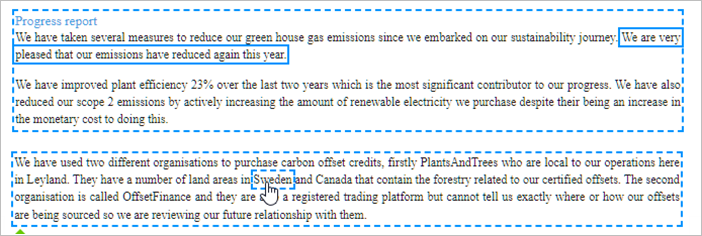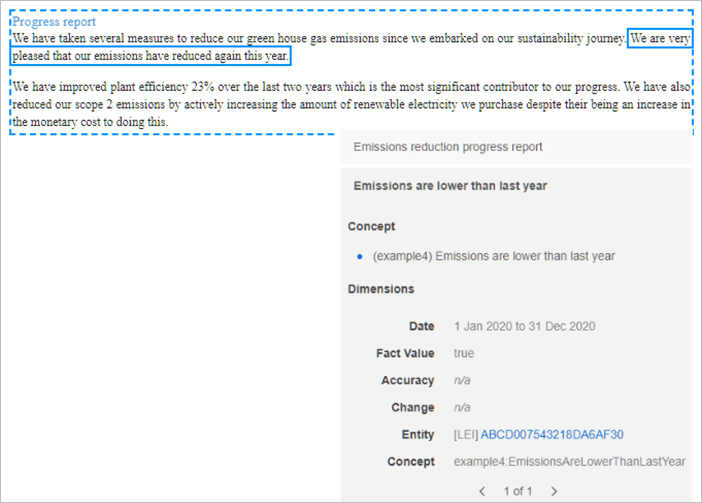Ensure narrative data granularity
Taxonomies should ensure that the granularity of reported narrative data is at a level where the results are accurate and useful.
Sustainability reports can be long and detailed, incorporating a significant number of descriptions and explanations that appear as multiple paragraphs of text. Different sentences or paragraphs answer different questions. One paragraph can answer two different questions, or several paragraphs are needed to answer one question.
If the narrative text is not tagged with taxonomy concepts at the correct level of granularity, it is difficult to analyse and find information in the report.
XBRL standard and narrative data granularity
XBRL taxonomies define how data preparers construct their reports, including narrative data. If taxonomies ensure the correct granularity of their concepts, reports built on those taxonomies will maintain a similar level of granularity, including narrative data.
The granularity of the tags in the narrative data should be balanced so that the data consumers receive the required information at the correct level of detail.
The XBRL tags should make it easy for data preparers to see which data satisfies a particular requirement of the sustainability standard. Organise the granularity of the narrative tags to produce the required results without excessive tagging.
XBRL provides the following solutions to maintain a healthy balance of granularity:
- The XBRL taxonomy indicates the correct level of granularity.
- Multiple paragraphs can be tagged with a single concept. It allows the flow of text to be maintained, without losing the accuracy of the taxonomy.
- The narrative text can be tagged at section, paragraph, sentence, phrase or word level, maintaining the precision when reporting data.
- It is possible to tag narrative report content with both numeric and non-numeric taxonomy concepts.
- Data preparers can tag text that is part of an already tagged text.
Example
A data preparer files a progress report about greenhouse gas emissions, which consists of narrative data and tables.
CarMaker report (iXBRL format)
In the report, they include information about emissions reduction and carbon offset.
As you can see, the narrative data is tagged at different granular levels. The first level tags at a paragraph level, and the second level tags at a sentence level.

Let us take a closer look at the two first paragraphs.
The first fact, which tags the two first paragraphs, introduces the data without stating if the emissions are lower or not. It points data consumers to the location where the fact is reported.

The second fact, that tags only the sentence that introduces information about emissions being reduced, provides machine-readable information. The narrative data is reported as a Boolean Fact Value value.

More detail
Sustainability standards and granularity
Standard setters should consider data granularity when setting and explaining new standards. They should organize the standard’s structure so that taxonomies created to meet the requirements of those standards can achieve the correct level of information granularity.
Data preparers prepare their reports based on the provided taxonomy. The taxonomy should be constructed with the intention that its concepts define how data preparers construct their reports, including narrative data.
The correct granularity of reported narrative data allows regulators to efficiently extract data from the narrative text. Standard setters, regulators and data preparers should cooperate to improve the granularity level of taxonomy concepts and narrative data.
Report narrative data
To ensure the granularity of the reported narrative data, data preparers should remember about the following:
- Prepare the reports based on the provided taxonomy.
- Use different levels of granularity when tagging.
Don’t only tag large pieces of text with one taxonomy concept. Tag a section, paragraph, sentence, and word level. - Work with standard setters to define the granularity of the tags needed.
If you need to extend the taxonomy, add new values for the existing dimensions. - Provide feedback to the standard setters about your experience with reporting based on their taxonomy.
Transform narrative data to Boolean
The Inline XBRL (iXBRL) standard has a transformation mechanism that enables taking any tagged text and transform it to a fixed value of true or false. This mechanism makes it possible to link human-readable text to taxonomy concepts expecting Boolean data.